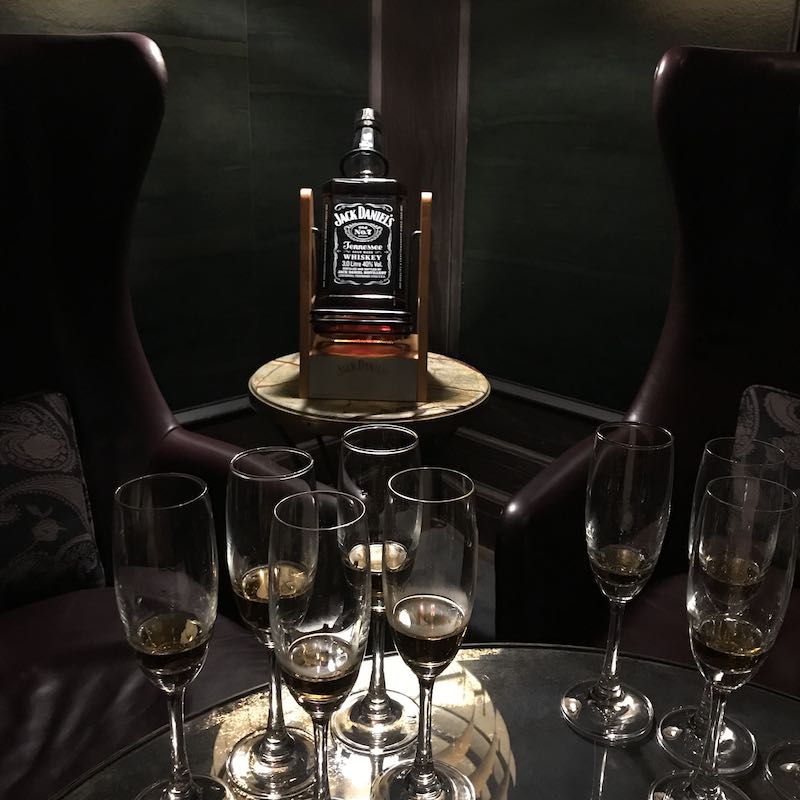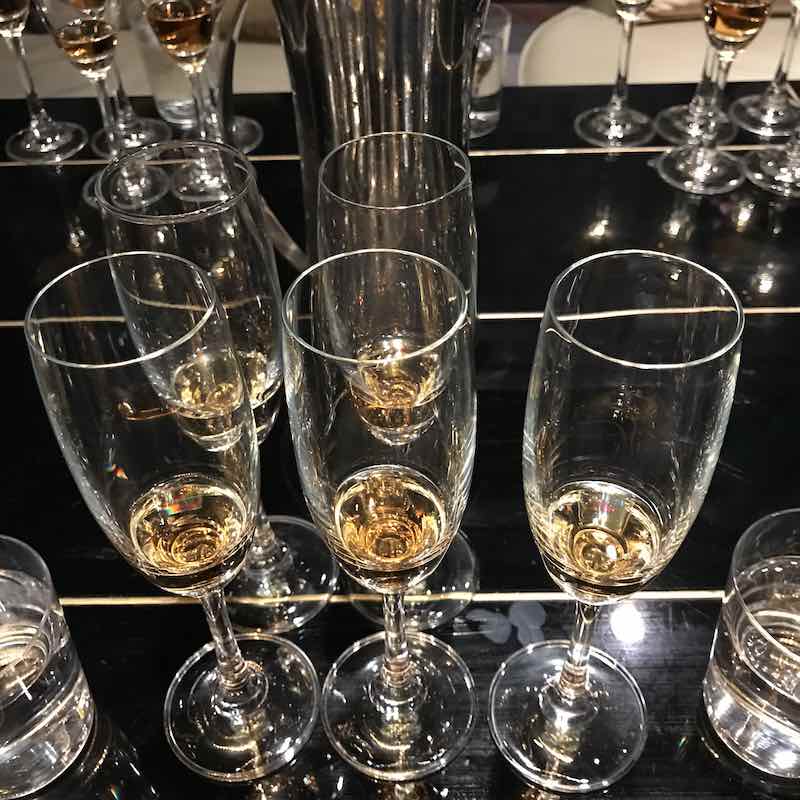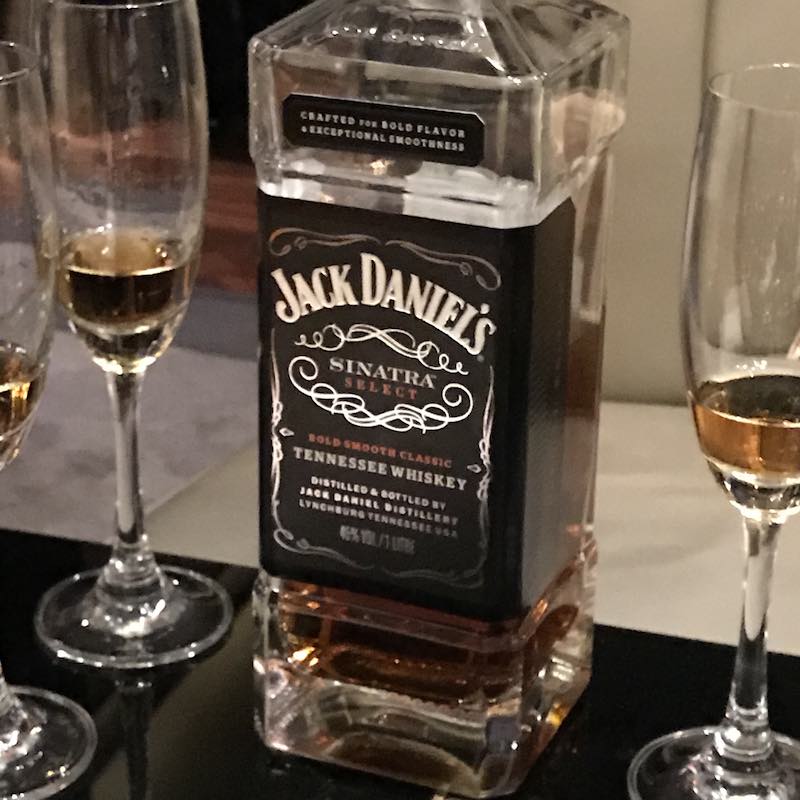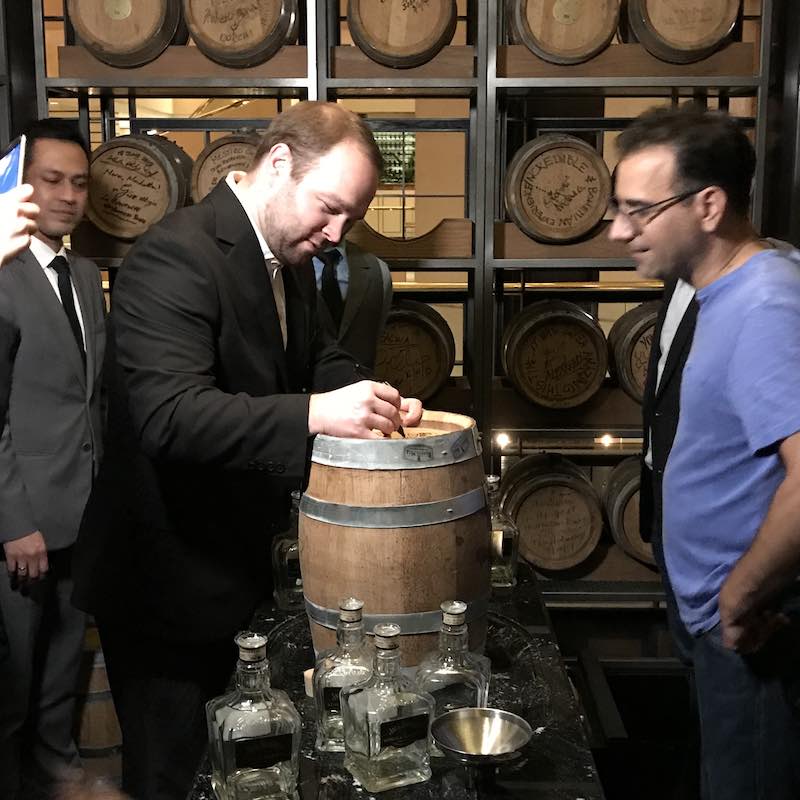Date Night with Jack Daniel at Asia’s Number One Bar

Canon JD No. 7 with tasting glasses
Geek Flora and Choc were invited to a tasting session of Jack Daniels on 6 May 2018 at Manhattan Bar. It was an awesome evening because tasting a famous Tennessee at Asia’s Number One Bar can never go wrong. Besides, the assistant Head Distiller, Mr Chris Fletcher, was in town and we knew that he would answer all our geeky questions.
We reached Manhattan Bar around 7 pm, and the reception ushered us into a private room next to the main bar floor on the right. What we saw was absolute class and luxury as the tall glasses laid in their full glory with the gold nectar within them. The room smelled of whiskey (of course), and we got a little more excited.
Introducing Jack Daniel as a person
In case you do not know, Jack Daniel was indeed a real person. Nobody truly knows Jack’s birthdate, but official records from the distillery stated the 1850s. He was the youngest of 13 children and was very young when his mother died. His father remarried but unfortunately killed shortly after that in the Civil War. Jack did not get along with his stepmother, and hence, he ran away from home at a young age. Jack ended up in Lynchburg, Tennessee where a local lay preacher and moonshine distiller named Dan Call took him in.
Jack began his career as an apprentice distiller with Call and his Master Distiller, Nathan Green. In 1875, Jack received an inheritance from his father’s estate and founded Jack Daniel Distillery with Call. However, Jack took over the distillery shortly afterwards as Call decided to answer his true calling as a preacher.
Jack Daniel Distillery
Jack soon expanded the distillery in 1884 by purchasing the surrounding land. He was getting recognition from the public, and the whiskey gained popularity in the 1880s. The distillery began to bottle their liquid in square bottles in 1897 to convey a sense of fairness and integrity. In 1904, Jack Daniel won a gold medal at the St Louis World’s Fair, and the distillery experienced a surge in demand. However, things looked bad at home with Prohibition oncoming.
Jack gave the distillery to two of his nephews in 1907 due to failing health and died in 1911 due to blood poisoning. One of them became the next owner for 40 years while the other sold his share early. Prohibition laws passed in Tennessee in 1910 and the distillery halted its production in Lynchburg. Two other sites in St Louis, Missouri and Birmingham, Alabama started distilling but failed to produce quality liquid. In 1920, the United States of America passed nationwide prohibition laws, stopping further distillation from taking place.
Despite it all, Lemuel “Lem” Motlow held his uncle’s legacy through the Prohibition and was the front mover in repealing the Tennessee state-prohibition law in 1938. After that, things ran smoothly until 1942, where the U.S government banned production due to World War 2. After the war, Motlow resumed Jack Daniel in 1947. Sadly, he died in the same year and left the distillery to his children.
Jack Daniel distillery began its modern era in 1956 when Brown-Forman bought the distillery from the Motlow family.
The Making of a Tennessee Whiskey
Did you know the difference between a bourbon and a Tennessee? To confuse you a little, a Tennessee can be bourbon, but bourbon can never be a Tennessee. Why!?
The definition of bourbon defines it as a liquid made anywhere in the U.S with at least 51% corn and matured in a brand new charred oak cask. The alcohol content of the new make must also be 80% or lower. A Tennessee is a bourbon produced in Tennessee and treated with maple charcoal before maturing in a brand new charred oak cask. The process, called charcoal mellowing, makes all the difference between a Tennessee and a bourbon.
Charcoal mellowing helps to maintain the flavour consistency and soften the whiskey to make it less harsh. Hence, a Tennessee whiskey is always easier to drink than a typical bourbon.
The Making of a Jack Daniel Tennessee Whiskey
Jack Daniel distillery sources its water from an underground cave spring. The grain percentage is 80% corn, 12% malted barley and 8% rye. The distillery milled the corn and cooked it with hot water to turn it into grist before adding the rye. After that, they allow the mixture to cool before adding the malted barley to the mash. The fermentation team then pumps the mash into the fermentation tanks and add yeast. When fermentation completes, the alcohol abv is around 12%.
Distillation then begins in the 100% copper stills. The 40ft tall column still brings the vapours into a short still with copper plates heated by steam. The system separates the alcohol and then distil it a second time before cooling off into new make. The liquid then passes through 3m of charcoal made on-site for the charcoal mellowing process. The entire process takes about two to three days. After that, it becomes Tennessee whiskey at 70% abv.
Jack Daniel’s Barrels
As you know, all American whiskey needs maturation in brand-new charred American oak. Jack Daniel is no difference. Their Tennessee whiskey sleeps in brand-new charred American oak casks for at least four years and mostly less than eight years. There is no additional colouring. Maturation in Tennessee is different from Scotland – they need hot summers. Hot summers mean maturation is likely to conclude in five to six years while cooler summers will result in a slightly longer maturation.
Jack Daniel resells all their barrels after using as they are not allowed to use it for the second time. About 25% of all ex-bourbon barrels in the world are Jack Daniel’s!
Jack Daniel’s Cooperage
Jack Daniel also owns two cooperages and have a patent barrel-making process. They buy oak trees, cut them up and build their barrels from scratch. The newly-made barrels are toasted for 17 minutes at 260 degrees Celsius to get the creamy vanilla and caramel into the wood before getting charred for 25 seconds. The cooperages make about 2,000 barrels every day.
The Tasting of Jack Daniel’s Range

The beautiful glasses for Geek Flora
After reading so much about Jack Daniel, it is time for us to take you on the tasting journey for the night. We had a total of six expressions. They are Gentleman Jack, JD Single Barrel, JD No. 7, JD Gold No. 27, JD American Straight Rye, and JD Sinatra Select. Chris Fletcher, the assistant Head Distiller (pictured below) waxed lyrical about the distillery and its whiskey-making methods, which delighted us (and resulted in the long explanation above)!

Mr Chris Fletcher, Assistant Head Distiller at JD
It is now time to delve into the various JD and see how they are.
Gentleman Jack
As the name suggests, this whiskey is a complete gentleman. Soft-spoken and gentle, the nose is full of melons, pears and bananas with just a hint of oak. The palate is creamy, fruity and soft. Elegant indeed. The finish is too short, but Chris mentioned that the distillery makes it this way as it is an entry whiskey for those who just started learning about whiskey.
JD Single Barrel
A little note about the single barrel: the distillery chooses their single barrels only from the top floor of specific warehouses within the distillery. As they build their warehouses on sites of different heights, the top floor of each warehouse differs from the other. As Jack Daniel depends on the weather for maturation, location of each warehouse plays a big part. The highest floor of each warehouse naturally gets the most heat and hence, considered as one of the best.
The JD Single Barrel is a colossal sugar babe. The nose boasts of molasses, vanilla, melons and Juicy Banana chewing gums. The palate is sweet with molasses, vanilla, melons and spice. It is oily and less creamy than Gentleman Jack. Hints of Juicy Banana chewing gums reappears behind the spice. The finish is medium with oak and ripe banana sweetness. Hints of sweet sandalwood appear with the second sip.
JD No. 7
JD No. 7 is well-known in this part of the world, and almost everyone had a JD No. 7 before. The nose is full of molasses, melon and light vanilla. The palate is creamy with vanilla and spice. We get hints of banana sweetness at the end. The finish is too short, with faint banana sweetness and a bit of oak.
JD Gold No. 27
The JD Gold No. 27 is an unusual expression. It matures four years in oak before transferring to a maple barrel for six months to a year. The nose boasts of bananas, vanilla and maple syrup. The palate is exceptionally creamy, with molasses, banana, maple and spice at the back of the palate. The finish is medium, creamy and slightly spicy.
JD American Straight Rye
The JD rye is a new expression launched in September 2017 that consists of 70% rye, 18% corn and 12% malted barley. The nose is full of banana cream, light spice and sweet sandalwood. The palate brings the sandalwood to the front, with banana cream, earthen spice and light mint at the back of the palate. The finish is short and spicy.
JD Sinatra Select

JD Sinatra Select
Finally, the JD Sinatra Select is an expression made to commemorate Sinatra’s 100 Years. He loved Jack Daniels and would promote the brand blatantly even though they never paid him a single cent for advertising. Therefore, this expression celebrates the man who loved his JD.
The nose is oaky, oily with vanilla in the background. The banana scent that is so distinctive JD is weaker too. The palate reveals dry oak, vanilla, bananas and hints of sandalwood. There is some spice also. The finish is medium, with sweet vanilla and oak. It gets slightly dry at the end.
A Wonderful Night Indeed

Chris signing the barrel after pouring in the bottles of Gentleman Jack
The tasting session ended with Chris pouring in a few bottles of Gentleman Jack into a barrel at Manhattan Bar to barrel age the whiskey further. As it is part of Manhattan’s barrel-aged program, we may have the chance to try the liquid after the maturation! We shall wait in anticipation.
We certainly enjoyed ourselves that evening and got to know Jack Daniel better as a brand and as a whiskey. We are apparently amazed by the different expressions and have since changed our minds about JD. Just like our friend, Brendan from The Single Cask, said, “So many years of prejudice against Jack Daniels, and it was washed away all in one night.” We feel the same way too!


